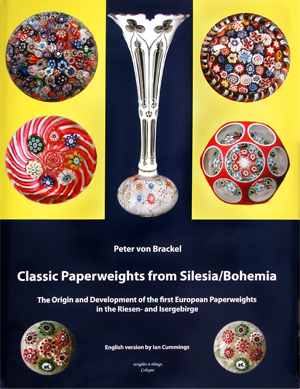Classic Paperweights from Silesia/Bohemia
The Origin and Development of the first European Paperweights
in the Riesen- and Isergebirge
by: Peter von Brackel
2010, Weights-n-things, Cologne, Germany
340 pages, $120. hardbound.
flyleaf: “Peter von Brackel’s first book “Paperweights: Historicism, Art Nouveau, Art Deco - 1842 to present-”, published in English in 1999 by Schiffer Publishing Ltd., Atglen, PA 19310, has become a standard reference work on the subject of post-classic paperweights. With this second book “Classic Paperweights from Silesia/Bohemia”, the author has closed the gap in the line-up of specialist literature dealing with those mid-19th Century classic paperweights, which originated in the Riesen-Isergebirge, the border region between Silesia - which at the time belonged to Prussia - and Bohemia, which was part of the Austro-Hungarian Empire. Up to now, relatively little detailed information was available about this region in Central Europe where the world’s first paperweights were produced in the early 1840s. This book will help scholars and collectors to determine which classic paperweights originated in Silesia/Bohemia and allow them to be attributed to the relevant group. Admittedly there is still some conjecture about a number of the groups and this will probably remain so in the future due to a lack of positive documentary evidence. Where this book will certainly prove invaluable is in correctly classifying the major groups of Silesian/Bohemian paperweights - and the glassworks which made them: Karlstahl, Josephinenhütte, Harrach, Eggermann etc.
In addition to discussing the developments which culminated in the production in the Riesen-/Isergebirge region, the book provides detailed explanations, accompanied by numerous illustrations, about the various groups of classic paperweights known to have been produced here. The book also includes examples of early post-classic paperweights from Silesia, Bohemia and Thuringia. Apart from the pictures of some of the people involved, the glassworks and two maps (to provide readers with a better idea of the geographical location of the area) - the book contains over 600 photographs of paperweights, paperweight related items and other glass objects - all in all, 830 pictures including profile, base and detail images as well as drawings. In addition, there are more than 2,800 illustrations of individual millefiori canes. There is also a detailed glossary of paperweight terminology, a chronological classification of paperweights and an index of names, glassworks and museums. The 340-page hardback book is printed in letter format.”

